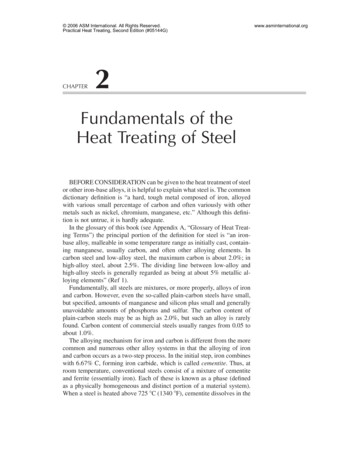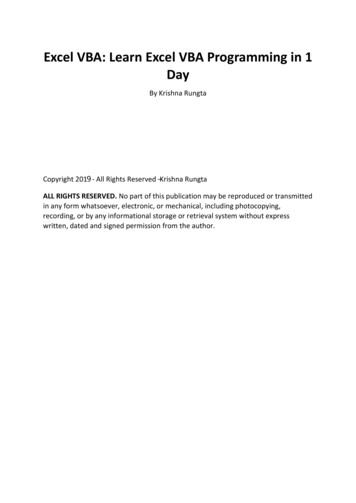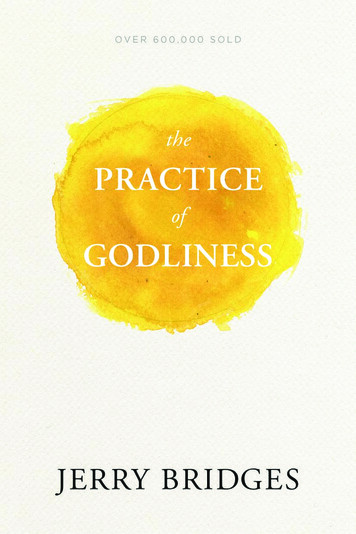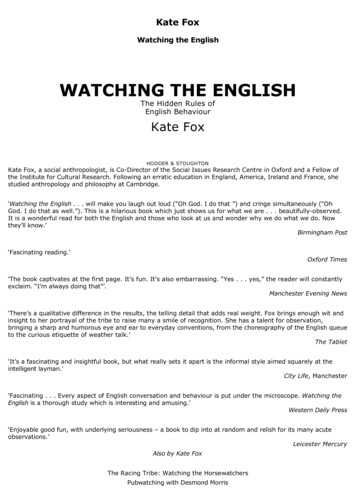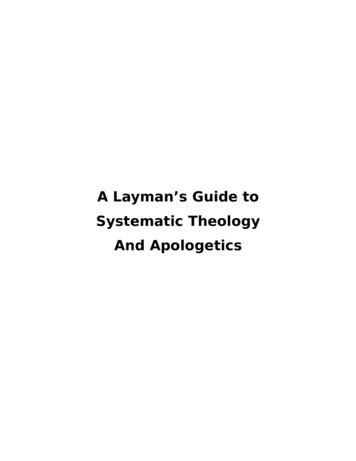
Transcription
A Layman’s Guide toSystematic TheologyAnd Apologetics
2Table of ContentsBook OneI.AcknowledgementsII.Bibliology: The Doctrine of ScriptureIII. Theology: The Doctrine of GodIV. Christology: The Doctrine of ChristV.Pneumatology: The Doctrine of the Holy SpiritVI. Anthropology: The Doctrine of ManVII. Soteriology: The Doctrine of SalvationVIII. Ecclesiology: The Doctrine of the ChurchIX. Eschatology: The Doctrine of the End TimesBook TwoI.II.III.IV.ApologeticsA. Christian Cults1. Jehovah’s Witnesses2. Mormons3. Word of Faith Movement4. Gnosticism5. The Jesus Seminar6. A Note on the Catholic ChurchB. False Religions1. A Comparison of World ReligionsC. Secular World Views and Philosophies1. Relativism2. Darwinism (Evolution)3. Secular HumanismConclusionResources for Further StudyBibliography
3AcknowledgementsIt is my sincere hope and prayer that this book will be a help to the Christian layperson.That it will be a means of equipping the saints for the work of ministry. I felt the need towrite this; mainly because of my experiences as a pastor in which I found that manyChristians could not give a reason for what they believe, nor did they even know orunderstand what their beliefs were. In America many a person claims to be a Christiansimply because he or she was born a United States citizen. Others claim to be Christianssimply because their mother and father were Christians. While others still claim that theyare Christians because they were baptized in water. This clearly shows a lack of Biblicalunderstanding among confessing Christians, at least in the U.S.I have tried to write this book in a way that the common layperson can easily understandit, and though it is not an exhaustive systematic theology I have tried to cover as many ofthe bases that I could, without getting too bogged down in theological lingo andterminology. I must stress that this book is only intended to be an aid to Christians, ameans to assist in the study of God’s word, in theology, and apologetics. And as it iswritten by a fallible human, it should not be considered gospel or without errors. There isno doubt that Arminians will disagree with much of it, as will liberal theologians, as maysome evangelicals.I have written it in two sections, the first dealing with theology and doctrine, and thesecond with apologetics. The first is in the form of a summary as it would take severalvolumes of books to lay out the entire Christian Theology in book form. The secondsection I have tried to give brief backgrounds to the most common non-Christianreligions and teachings and then refutations to those religions, cults, and false doctrines.Having earned my degree in History I have chosen to use the Turabian (Chicago) style offootnoting and bibliography simply because I am more comfortable with that style.Some thanks are in order. I would first like to thank my father, Ken McKinley Sr. whosereturn to the Lord was no doubt a major influence in my coming to Christ. He has beenand continues to be a great inspiration of faith to me. I would also like to thank my wife,MariJo McKinley, whose patience and understanding allowed me to stay up late nightswhile writing this work. (I love you honey). I owe a great deal of thanks to my uncle,Gary McKinley who has helped me get this published. I must also thank the numerouspastors, evangelists, apologists, Bible teachers, professors, and theologians who haveinfluenced me throughout the years in so many ways; men of faith past and present, greatis your reward. Most importantly, I must thank my Lord and Savior Jesus Christ, whosaved the worst among you, when He saved a wretch like me. Without Him I could donothing.To my daughters, Leslie and GabrielStudy to show yourselves approved workers that need not be ashamedRightly dividing the Word in Truth
4Book OneBibliology: The BibleThe term Bibliology comes from the Greek word biblos, meaning “book”. It literallymeans, “The study of the Book” with the “Book” being the Bible. Bibliology oftenincludes such topics as revelation, inspiration, inerrancy, canonicity, illumination andinterpretation, AKA hermeneutics.RevelationThe term “revelation” means to “unveil” or “uncover”. Biblically speaking, revelation isthe act and process whereby God makes Himself known to us. He has done this invarious ways, including miracles, visions, dreams, creation, providence, conscience,Jesus Christ, and Scripture. Theologians have spoken of “general” revelation throughnature, conscience and providence and “special” revelation found in Christ and inScripture (Ps 19:1-6; Romans 1:18-20, 2:14-16; Acts 17:24-34; John 1:14-18).Thus general revelation is equally available to all men at all times and while it alonecannot save, it is nonetheless both essential and preparatory to special revelation.1General revelation is also one of the reasons all mankind is guilty before God (SeeRomans Chs. 1 & 2).Inspiration“Inspiration” is the theological word, derived from the Latin term spiro, used to refer tothe process whereby God superintended the human authors of scripture so that what theywrote was simultaneously their own words as well the Word of God Himself; God“breathed out” His words through the writings (using the minds and personalities) of Hisspokespeople (2nd Timothy 3:16). Thus, through Spirit-inspired writings God haspreserved an historical/theological record of His words and deeds and has given it to Hiscovenant people as a means of grace that they might trust Him fully and obey Himimplicitly. As a result of our sinfulness and finiteness we stand in need of such divineguidance and wisdom; scripture was inspired to that end.Inspiration, however, is not limited to mechanical dictation (indeed, very little of it can besaid to be mechanical in any way), as we might have, say, in the receiving of the TenCommandments (or the letters to the churches in Revelation 2-3), but rather, occurred ina variety of situations involving the writers as whole people (their minds, emotions, wills,etc.) in their own particular life situations (linguistic, religious, political, economic, etc.).The end product, however, was always God’s Word to man through man (2nd Tim 3:16;2nd Pet 1:20-21) and carries God’s “full weight and authority.” Technically speaking,inspiration applies to the autographa (not later copies or translations).Some theologians have referred to the verbal (extending to the actual words, not justconcepts), plenary (the entire Bible, not only those parts that seem to speak directly toissues of faith and practice) inspiration of Scripture. This is the view that (1) bestcorresponds to the view of OT writers, the prophets, Christ Himself and His apostles, and1The objective revelation of God through nature, history, and conscience (human nature) is notextinguished because of man’s fall (see Psalm 19:1-6; Rom 2:14-15; Acts 17:26-27), but is seriouslydistorted through suppression and deliberate contempt (Rom 1:18-20).
5(2) best represents the historic position/understanding of the church on this issue. Sincethe Enlightenment in France and Germany (17th/18th centuries), however, it has beenfashionable to deny the verbal plenary inspiration of Scripture in light of apparenthistorical inaccuracies and philosophical objections, particularly with the existence andnature of God as well as the limitations of language. But, while we can learn much fromthese views, we may safely set aside their anti-super naturalistic prejudices as bothunfounded and contrary to the teaching of Jesus who Himself strongly upheld thecomplete trustworthiness of Scripture without reserve (e.g., Matt 5:17-20).InerrancyInerrancy, although not always properly defined, is a logical companion to inspiration andin no way diminishes the human authorship of scripture. If what the authors of Scripturepenned was indeed under the supernatural influence and guidance of the Holy Spirit (as isproperly affirmed), then since God is true, what they wrote and affirmed is in all waystrue as well. Thus inerrancy applies to the autographa and Greek, Hebrew, and Aramaiccopies insofar as they faithfully reproduce the autographa. The doctrine rightly teachesthat the scriptures are without error in all that they affirm (i.e., properly interpreted),whether they refer to geographical, historical, or theological issues. Thus the scripturesare the final authority in matters of faith and practice and take precedence over tradition,culture, and creed. This doctrine also allows for different literary styles, poor grammar,approximations in numbers, etc. (Psalm 119).CanonicityThe sixty-six books of scripture constitute the Protestant canon in that they provide God’srule for faith and life. The process of canonicity involves the church’s recognition of thedivine origin and authority of the sixty-six books of scripture. The church, as theredeemed community, made up of those of those who have genuine faith in Jesus Christ,is qualified for this task. It is important to note, however, that the church did notdetermine which books were canonical, but only recognized those books which werecanonical; scripture is self-authenticating. In the case of the Old Testament, generallyspeaking, the church received it as the authoritative Bible of her Lord and His apostles,i.e., the prophetic message of God which was now fulfilled in and through Christ. In thecase of the New Testament, the church, by applying varying tests such as apostolicity(was it written by an apostle or authenticated by an apostle?), universality (was it widelyread and accepted?), and character (sufficiently spiritual, directed at godliness, doctrinalcontent in agreement with other apostles) recognized which books were “from the Lord”and which were not, though the process was by no means finalized by the end of the firstcentury. In AD 367, in the 39th Easter Letter of Athanasius, we find a list of the 27 booksof the NT we have today. This list was accepted by the churches east of theMediterranean while churches in the west came to accept the same list some 30 yearslater, in AD 397, at the Council of Carthage.2There are undoubtedly many reasons which prompted early Christians to preserve thewritings of the apostles, but perhaps the passing away of the apostles as well as the2For more information on the canon of Scripture, see Roger Beckwith, The Old Testament Canon of theNew Testament Church and Its Background in Early Judaism (Grand Rapids: Eerdmans, 1985); F. F. Bruce,The Canon of Scripture (Downers Grove, IL: InterVarsity, 1988); Harry Y. Gamble, The New TestamentCanon: Its Making and Meaning, New Testament Series, ed. Dan O. Via (Philadelphia: Fortress, 1985);Bruce M. Metzger, The Canon of the New Testament: Its Origin, Development, and Significance (Oxford:University Press, 1987).
6development of heresies and doctrinal disputes, were two of the most significant. Also,the Diocletian persecution (AD 303-11), in which Christians were tortured, their propertytaken, and their sacred books destroyed by fire, undoubtedly helped to move the churchalong in its recognition of which books were sacred (i.e., inspired) and which were not.That is, there arose the need to know which books to copy and preserve in light of thepossibility that the state continue to try and destroy the faith.The extent of the canon has been in some question among Protestants and Catholics sincethe addition of the Apocrypha at the Council of Trent (AD 1545-63). Anyone who hasread these books may find them encouraging, much the same as reading great Christianliterature, but they should not be regarded as on par with the 66 books, a fact which isrecognized even by the Catholic Church in its reference to them as deuterocanonical.IlluminationIllumination refers to the work of the Spirit in the believer/believing community enablinghim/her/them to understand, welcome, and apply Scriptural truth (cf. 1st Cor. 2:9-14).3 Forour part, we are to follow sound methods of interpretation in keeping with the nature ofScripture and generally accepted principles for understanding written communication.Further, we are, by faith in Christ, to put into practice that which the Scripture teaches us,lest we become blinded by our accumulated ignorance (James 1:21-22) and progressivelyblurred in our comprehension of spiritual realities. In this way illumination increases andour grip on the truth strengthens (or perhaps its grip on us!).InterpretationIf Illumination is the work of the Spirit to help believers understand and apply Scripture,interpretation, broadly conceived, is the thought-through method we should follow in thisendeavor. Interpretation involves, then, three elements: (1) coming to scripture humblywith a knowledge of my presuppositions, traditions, and cultural influences so as not toblunt or skew the force of scripture (but rather to allow it to leave its mark on me); (2)understanding what an author meant when he said such and such, and (3) understandingwhat he means, that is, how it applies to our lives today. Thus, in the first step we areinterested in gaining an awareness of how our culture, tradition, and past acquaintancewith Scripture have affected us. In the second step we are interested in the grammaticalhistorical meaning of a passage of Scripture. In order to achieve this we study the wordsof a text in their historical and grammatical context, the literary structure of a passage, itsmood, and the kind (genre) of literature it is. Combined with this is the comparing ofscripture with scripture (e.g., interpreting the obscure by the clear) and ultimately theteaching of the Bible as a whole. In this way, and through the illuminating work of theSpirit, the church comes to grips with the meaning and abiding relevance of Scripture.But this is only half the job. Moses did not write Deuteronomy and Paul did not penPhilippians simply to be understood (i.e., between one’s ears). Rather, they wrote to save,guide, instruct, and even discipline other believers to God’s will. In short, their writingscall for a response and this involves first letting the Bible speak to the reader; convicting,educating, encouraging, and showing us where to go. We must bring our presuppositions3The entire passage from 2:6-16 has received no little attention in recent years. But even though there aredisagreements regarding grammar, background, and theological emphases, there can be little doubt that therelevant thought for our purposes is quite clear: man in his unregenerate and carnal state cannot understandand accept the things of God (e.g., the cross-centered gospel), whereas the believer, who enjoys theenlightening ministry of the Spirit (cf. Eph 1:18), is able to welcome God's truth—now preserved for us inScripture—in a deeply personal and transformative way.
7and patterns of life to the passage and allow it to judge and straighten. Then we mustallow the Scripture – as the very voice of God Himself – to influence our beliefs andworld views according to His will. We must be careful to not fall into the trap of readingwhat we believe, and instead make sure that we believe what we are reading. TheLordship of Christ extends to the entire universe, and we must remember that His word isa primary way in which He expresses His grace oriented, kingly rule over us.HermeneuticsBiblical hermeneutics, the art of interpreting the Bible, aims to develop rules for itsinterpretation. Given below are two basic rules with important refinements for each, andthese rules are based on the conviction that the triune God for the sake of His electprogressively revealed Himself, according to His own immutable counsel, through theinspired authors, and providentially superintended the collection of their writings into thecanon, the Bible, to His own eternal glory.Rule One: Interpret the Words of the Bible in the Light of Their Historical Context.The different parts of the Bible must be interpreted according to the grammaticalhistorical method, that is, by studying the meaning of its words in the light of the timeand place they were originally written. The books of the Bible are quite old, much olderthan other books most people have ever read. The world of the Bible is so different fromours that sometimes a translation cannot bridge the gap between these ancient texts andmodern readers. But translators of this Bible and the contributors of the notes have notreinterpreted the Bible to suit modern attitudes; neither should the reader.The application of the first rule is complex because the Biblical writings were continuallyrelocated as the canon of Scripture progressively expanded. In this unfolding contextearlier texts take on fuller senses. For example, the individual psalms addressed to thepeople in the first temple period became finally the written Word of God to the covenantpeople as a whole after they were collected and arranged in the Book of Psalms. Fromthis point, the psalms had to be read and meditated upon (Ps. 1) in the light of their newliterary social contexts. For example, Psalm 2, which proclaims Israel's king as the idealson of God with a mandate to rule the earth through prayer and power, was sung beforethe Exile in the first temple, probably at the coronation of Israel's kings. When the Bookof Psalms was edited after the Exile, however, Israel's throne was vacant, waiting for apromised king, “the Messiah.” In that light Psalm 2 became purely prophetic. After thecoming of Christ the Psalms became part of the Bible that included the New Testament;in that light “the Messiah” of Psalm 2 takes on its fullest and clearest sense: He is noneother than the Lord Jesus Christ. Understanding the Bible fully means keeping an eye onthe developing stages of revelation.Rule Two: Interpret the Parts of the Bible in the Light of the Whole.The second important rule of interpretation is often called “the analogy of faith.” Thisrule asserts that Scripture interprets Scripture. The Bible itself says that all its parts areinspired by God (2nd Tim. 3:16), who is not a God of disorder (1st Cor. 14:33). The rule iscorroborated by the existence of the Bible as a single volume. The collection of sixty-sixbooks, written over a span of fifteen hundred years, into one book, reflects the church'sconviction that the transcendent Author superintended the collection of the many writingsinto a harmonious whole. Interpretation that pits Scripture against Scripture dishonorsthe Alpha and Omega, who sees and rules from the beginning to the end of all things.
8More specifically, the Old Testament must be interpreted in the light of the NewTestament. This is required for both literary and theological reasons. In a linguisticdiscourse the flow of thought keeps screening out unintended meanings. For example,the word “before” in the statement, “she sang before the Queen,” is ambiguous until thespeaker adds “before the Queen rose to speak,” or “before the Queen on her throne.” In asimilar way, as God's story of revealing and establishing His kingdom unfolds,ambiguous texts become clearer. For example, the ambiguous “offspring” (one ormany?) in God's promise to Abraham (Gen. 22:18) becomes focused on Christ (Gal.3:16). The unidentified maiden and Immanuel of Is. 7:14 are seen to be the Virgin Maryand her Son (Matt. 1:23), and the anonymous Servant in Isaiah (42:1-4; 49:1-6; 52:13 53:12; 61:1, 2) is revealed as Jesus, the suffering and yet triumphant Savior (Matt. 12:1821; Luke 24:44-49; 1st Pet. 1:11).This rule is required theologically. Christ, who through the Holy Spirit administers HisWord to the apostles, is not only the final but also the best revelation of God. God spokeat various times in various ways in time past (Heb. 1:1), including his revelation to Mosesand to the prophets. In spite of their varying psychologies by which God revealedHimself to them, all biblical authors write with infallible authority. But they are not ofequal weight in interpretation, as the conflict of Aaron and Miriam against Moses makesevident. Moses' brother and sister, themselves both prophets, challenged the priority ofMoses' words over theirs (Num. 12:1, 2). In reply, God censured them for their pride,arguing that Moses' words were superior because God gave Moses a more intimate andclearer revelation than He gave to them (vv. 6-8). The story establishes the importantprinciple that the forms of revelation require a hierarchy of interpretive priorities. Christis as much greater than Moses as a Son over a house is greater than a slave within it (Heb.3:5, 6). If Aaron and Miriam should have feared to make themselves equal with Moses,how much more should readers fear to make the Old Testament superior to the NewTestament that completes it? In fact, as the conversation between Philip and the Ethiopianofficial shows (Acts 8:30, 31), the Old Testament cannot be fully understood without theNew Testament. This does not mean that the New Testament corrects the Old Testament,but that it provides greater clarity in understanding the Old Testament.With these two fundamental rules in hand we can now proceed to refine them. Thegrammatical, historical method recognizes that different kinds of literature, or “genres,”such as history, law, poetry, and prophecy, in the Old Testament, and parables, and lettersin the New, will require different rules of interpretation. For example, in contrast to legalliterature, prophetic literature, as Numbers 12:6,7 makes plain, is frequently symbolic andfull of figures of speech, such as metaphor, personification, and metonymy. Moreover,the prophet's symbolic visions and dreams have taken their hue and coloring from theirhistorical situations. For example, at the threshold of prophecy God warns the serpent:“He [the woman's offspring] shall bruise your head, and you shall bruise His heel.” Thisis not a myth about the antipathy between humans and snakes, but a statement about theconflict between Christ and Satan (Rom. 16:20); the prophecy took its coloring from thesituation in the garden.This kind of symbolic language becomes even more intensified and extensive inapocalyptic literature such as Daniel in the Old Testament and Revelation in the New.The Ishtar Gate of Nebuchadnezzar, now in a museum in Germany, will readily explainwhy Daniel had fanciful dreams of animals. On that gate through which Daniel passed
9many times, the patron deity of Babylon's chief administrator, saw a lion with the wingsof an eagle leading a train of other bizarre animals representing Babylon and successivekingdoms (Daniel 7).The Old Testament prophets, using the images of their world to show the greatness ofChrist's rule from His heavenly throne, supercharged the old figures. To portray theheavenly character of Christ's rule, for example, Mount Zion is described as the highestmountain, presumably, were it known, higher than Mt. Everest (Mic. 4:1). To show theholiness of His kingdom, even the equipment of horses bears the inscription formerlyreserved for the diadem of the high priest, HOLINESS TO THE LORD (Zech. 14:20).Jesus used enigmatic parables in order to conceal His meaning from unbelievers and toreveal it to His disciples (Matt. 13). Emphatically, the first rule of hermeneutics does notmean that words are always to be taken in their plain, “natural” sense; the interpreter hasto take careful note of figures of speech and literary genres.Prophetic and apocalyptic literature in the Old Testament and Christ's parables in the Newmust not be read in the same way as Paul's letters. Just as encyclopedia articles cannot beread as poems, so also the Psalms ought not to be read like Chronicles. Relatively cleartexts like the epistles ought not to be interpreted in the light of the less clear propheticand apocalyptic literature; in-stead, the unclear should be read in light of the clear. Moresubtly, even such letters of Paul as those to the Corinthians, which assume the readerknows the situation the apostle is addressing, are less clear than an epistle like Romans,which logically sets forth the Christian faith within a particular historical context.Even what appears to be straight-forward history, such as Kings and Chronicles in theOld Testament, and the Gospels in the New, is not as straight-forward as may appearupon first reading. The inspired historians of both Testaments have carefully chosen andarranged their material to teach spiritual lessons according to the needs of their audiences.Sometimes incidents are arranged in topical or dramatic order rather than in a purelychronological sequence. For example, the Table of Nations in Gen. 10 chronologicallycame after Gen. 11, the story about the Tower of Babel, but Moses wanted his audience toview the nations under God's blessing (Gen. 9:1-17) and not under His judgment (Gen.11:9). Sometimes the line between historical and symbolic literature is attenuated as inthe stories of the early chapters of Genesis and, as some think, in Jonah. Specifically, noone thinks that Eve only was sentenced to return to the ground upon death (Gen. 3:1619). Every reader intuitively perceives that Adam and Eve represent every man andwoman. Nevertheless, the genealogies of the Old Testament and the teachings of NewTestament validate their historical character as well.The second rule, the “analogy of faith,” needs to be refined particularly with reference tothe political history of the Old Testament and its relation to the New. God is not pursuingtwo programs, one with earthly Israel and a second with the heavenly Church, aspopularized in dispensational teaching. Rather, the earthly presentation of the kingdom inthe Old Testament is typical of its heavenly and spiritual manifestation in the NewTestament. For example, the political and religious deliverance of Israel form Egyptthrough the Passover lamb, Israel's baptism in the Red Sea and the pilgrimage through thewilderness, sustained by manna from heaven and water from a rock, and then entranceinto the land of Canaan, depict in concrete terms the spiritual experience of the Church.The Old Testament history graphically portrays the exodus of the New Israel from theSatanic world with its bondage of sin and death through the Passover Lamb, Christ (1st
10Cor. 5:17), baptism into His death and resurrection, that is a death to the world and risingto the newness of His resurrection life (Rom. 6:3,4; Gal. 6:14), pilgrimage to theheavenly city, nourished by the sacraments of bread and wine (1st Cor. 10:1-17), and finalrest in the Promised Land (Heb. 4:6-11; 11:39,40). Israel's ritual, with its consecrated siteat Mount Zion, its sacred Sabbaths and seasons, its holy priests and kings, and itshallowed institutions such as animal sacrifice, symbolized the heavenly realities (Ex.25:9) now fulfilled since Christ entered the heavenly sanctuary (Heb. 9:10). The earthlyand temporal rituals were typical and became forever obsolete when Christ brought Hisglorified church to the eternal, heavenly realms. Today the church “is hidden with Christ”in the heavenly domains (Col. 3:1-4) and in the future He without a veil will be seen (1stJohn 3:2, 3). The Christian must read Israel's history and ceremonies not only with a viewto understanding what Israel's history and ritual meant at the time, but also with an eye totheir antitypical significance according to the New Testament.Moreover, the prophetic promises, molded according to the political expressions of thekingdom as known before Christ, must not be interpreted as having a future, carnalfulfillment based on the typical model that has forever been done away (Heb. 8:13), assome dispensational teaching has supposed. Rather, the promises must be read in the lightof the antitypical, heavenly, and spiritual realities that endure forever (2nd Cor. 4:18).Lastly, although the Bible is a very old book, it is addressed to you. When introducingcitations from the Old Testament, the New Testament writers frequently use the presenttense, “God says,” rather than “God said,” and they reinforced the present relevance ofHis ancient Word by adding, “to us” and “to you,” rather than, “to them” (1st Cor. 9:9,10).Both Moses and Paul say, “The word is near you, in your mouth and in your heart” (Deut.30:14; Rom. 10:8). Second, because the Bible is God's Word, do not read the Bible in thesame way as other books. Biblical writers consistently use such expressions as “Godsays” (Is. 1:18-20; Matt. 19:4; Acts 4:25). Often God says directly, “I say” (Mic. 1:6-8).Accept God's word in faith and mediate upon it with memorization, imagination, andreflection. And before reading, pray that the Holy Spirit might teach you what He would,so that you may rightly divide the Word of truth.
11Theology ProperTheology refers to the study of God, and more specifically, the triune God. It oftenincludes such topics as rational arguments for the existence of God, the attributes of God,the Names of God, the trinity, and the decree or plan of God.RATIONAL ARGUMENTS FOR THE EXISTENCE OF GODIt needs to be said up front that the Bible nowhere argues for the existence of God in theway envisioned in these “proofs.” The overwhelming orientation of the Biblical writers isto assume that God exists and then to move on from there. Also, the strength of thesearguments has been variously debated; some people find them helpful and generallyconvincing, especially when taken together, while others are not the least bit convinced.It is doubtful whether there is any necessary logical fault involved in denying any one oftheir premises or assertions since in many cases opponents are simply beginning with adifferent set of axioms. Further, there are many variations (i.e., more than onecosmological argument) of the arguments listed here. One should consult a textbook onthe philosophy of religion for further discussion.4 Also, one should note that thesearguments have been criticized by more than atheists. The following is simply anintroduction.The Argument from CreationThe argument from creation or ot
means to assist in the study of God’s word, in theology, and apologetics. And as it is written by a fallible human, it should not be considered gospel or without errors. There is no doubt that Arminians will disagree with much of i
